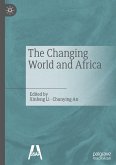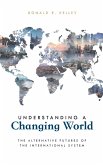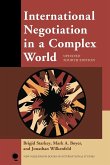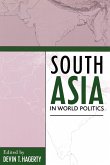- Broschiertes Buch
- Merkliste
- Auf die Merkliste
- Bewerten Bewerten
- Teilen
- Produkt teilen
- Produkterinnerung
- Produkterinnerung
The world is becoming more complex, with increasing possibilities for conflict over national rivalries, economic competition, and cultural and ideological fault lines. Understanding a Changing World offers a structured and theoretically grounded way to think about the forces that animate change and the alternative futures they may create.
Andere Kunden interessierten sich auch für
![The Changing World and Africa¿ The Changing World and Africa¿]() The Changing World and Africa¿106,99 €
The Changing World and Africa¿106,99 €![The Changing World and Africa¿ The Changing World and Africa¿]() The Changing World and Africa¿106,99 €
The Changing World and Africa¿106,99 €![GULF POLITICS AND ECONOMICS IN A CHANGING WORLD GULF POLITICS AND ECONOMICS IN A CHANGING WORLD]() Hudson MichaelGULF POLITICS AND ECONOMICS IN A CHANGING WORLD95,99 €
Hudson MichaelGULF POLITICS AND ECONOMICS IN A CHANGING WORLD95,99 €![Understanding a Changing World Understanding a Changing World]() Donald R KelleyUnderstanding a Changing World72,99 €
Donald R KelleyUnderstanding a Changing World72,99 €![International Negotiation in a Complex World International Negotiation in a Complex World]() Brigid StarkeyInternational Negotiation in a Complex World44,99 €
Brigid StarkeyInternational Negotiation in a Complex World44,99 €![South Asia in World Politics South Asia in World Politics]() Devin T. HagertySouth Asia in World Politics56,99 €
Devin T. HagertySouth Asia in World Politics56,99 €![With or Against the World? With or Against the World?]() James W. SkillenWith or Against the World?53,99 €
James W. SkillenWith or Against the World?53,99 €-
-
-
The world is becoming more complex, with increasing possibilities for conflict over national rivalries, economic competition, and cultural and ideological fault lines. Understanding a Changing World offers a structured and theoretically grounded way to think about the forces that animate change and the alternative futures they may create.
Produktdetails
- Produktdetails
- Verlag: Rowman & Littlefield Publishers
- Seitenzahl: 226
- Erscheinungstermin: 7. Januar 2021
- Englisch
- Abmessung: 229mm x 152mm x 13mm
- Gewicht: 374g
- ISBN-13: 9781538127940
- ISBN-10: 1538127946
- Artikelnr.: 60070165
- Herstellerkennzeichnung
- Libri GmbH
- Europaallee 1
- 36244 Bad Hersfeld
- gpsr@libri.de
- Verlag: Rowman & Littlefield Publishers
- Seitenzahl: 226
- Erscheinungstermin: 7. Januar 2021
- Englisch
- Abmessung: 229mm x 152mm x 13mm
- Gewicht: 374g
- ISBN-13: 9781538127940
- ISBN-10: 1538127946
- Artikelnr.: 60070165
- Herstellerkennzeichnung
- Libri GmbH
- Europaallee 1
- 36244 Bad Hersfeld
- gpsr@libri.de
Donald R. Kelley is professor of political science at the University of Arkansas, where he has taught international relations and comparative politics since 1980. He also served as a senior research fellow and then as director of the Fulbright Institute of International Relations.
1: Understanding a Changing World: The Future(s) of the International
System
Why Future(s)?
What Is an International System?
What Is a Paradigm?
Building Analytic Paradigms and Alternative Futures
Paradigms in the Social Sciences
Realism, Liberalism, and Constructivism
The Four Paradigms
What Comes Next?
2: The Nation-State
Paradigm
The Paradigm
The Possible Futures
A Hegemonic World
A New Balance of Power in a Bipolar or Limited Multipolar World
A Stable Multipolar World
An Unstable Multipolar World
3: The Economic Paradigm
The Paradigm
The Possible Futures
Globalization Advances
Globalization Amended and Reconfigured
Mercantilism 2.0
Toward Autarky, with a Touch of Anarchy
4: The Identity and Culture Paradigm
The Paradigm
The Possible Futures
The Gradual Emergence of a Global Identity and Culture
The Identity and Culture Paradigm Merges with the Nation-State Paradigm
The Creation of an International System Based on the "Clash of
Civilizations"
5: The Ideology Paradigm
The Paradigm
The Possible Futures
A Universalistic and Humanistic Ideology Emerges
Ideological Conflict Reemerges
"National Ideology" Becomes the Dominant Fusion of National Identity and
Ideology
Populism Becomes the Dominant Paradigm
Sources of Stability and Instability
What Would a Populist World Look Like?
6: Where Do You Go from Here?
What Have You Learned?
How Many Alternative Futures Have We Created?
How Can You Use This Framework?
Index
About the Author
System
Why Future(s)?
What Is an International System?
What Is a Paradigm?
Building Analytic Paradigms and Alternative Futures
Paradigms in the Social Sciences
Realism, Liberalism, and Constructivism
The Four Paradigms
What Comes Next?
2: The Nation-State
Paradigm
The Paradigm
The Possible Futures
A Hegemonic World
A New Balance of Power in a Bipolar or Limited Multipolar World
A Stable Multipolar World
An Unstable Multipolar World
3: The Economic Paradigm
The Paradigm
The Possible Futures
Globalization Advances
Globalization Amended and Reconfigured
Mercantilism 2.0
Toward Autarky, with a Touch of Anarchy
4: The Identity and Culture Paradigm
The Paradigm
The Possible Futures
The Gradual Emergence of a Global Identity and Culture
The Identity and Culture Paradigm Merges with the Nation-State Paradigm
The Creation of an International System Based on the "Clash of
Civilizations"
5: The Ideology Paradigm
The Paradigm
The Possible Futures
A Universalistic and Humanistic Ideology Emerges
Ideological Conflict Reemerges
"National Ideology" Becomes the Dominant Fusion of National Identity and
Ideology
Populism Becomes the Dominant Paradigm
Sources of Stability and Instability
What Would a Populist World Look Like?
6: Where Do You Go from Here?
What Have You Learned?
How Many Alternative Futures Have We Created?
How Can You Use This Framework?
Index
About the Author
1: Understanding a Changing World: The Future(s) of the International
System
Why Future(s)?
What Is an International System?
What Is a Paradigm?
Building Analytic Paradigms and Alternative Futures
Paradigms in the Social Sciences
Realism, Liberalism, and Constructivism
The Four Paradigms
What Comes Next?
2: The Nation-State
Paradigm
The Paradigm
The Possible Futures
A Hegemonic World
A New Balance of Power in a Bipolar or Limited Multipolar World
A Stable Multipolar World
An Unstable Multipolar World
3: The Economic Paradigm
The Paradigm
The Possible Futures
Globalization Advances
Globalization Amended and Reconfigured
Mercantilism 2.0
Toward Autarky, with a Touch of Anarchy
4: The Identity and Culture Paradigm
The Paradigm
The Possible Futures
The Gradual Emergence of a Global Identity and Culture
The Identity and Culture Paradigm Merges with the Nation-State Paradigm
The Creation of an International System Based on the "Clash of
Civilizations"
5: The Ideology Paradigm
The Paradigm
The Possible Futures
A Universalistic and Humanistic Ideology Emerges
Ideological Conflict Reemerges
"National Ideology" Becomes the Dominant Fusion of National Identity and
Ideology
Populism Becomes the Dominant Paradigm
Sources of Stability and Instability
What Would a Populist World Look Like?
6: Where Do You Go from Here?
What Have You Learned?
How Many Alternative Futures Have We Created?
How Can You Use This Framework?
Index
About the Author
System
Why Future(s)?
What Is an International System?
What Is a Paradigm?
Building Analytic Paradigms and Alternative Futures
Paradigms in the Social Sciences
Realism, Liberalism, and Constructivism
The Four Paradigms
What Comes Next?
2: The Nation-State
Paradigm
The Paradigm
The Possible Futures
A Hegemonic World
A New Balance of Power in a Bipolar or Limited Multipolar World
A Stable Multipolar World
An Unstable Multipolar World
3: The Economic Paradigm
The Paradigm
The Possible Futures
Globalization Advances
Globalization Amended and Reconfigured
Mercantilism 2.0
Toward Autarky, with a Touch of Anarchy
4: The Identity and Culture Paradigm
The Paradigm
The Possible Futures
The Gradual Emergence of a Global Identity and Culture
The Identity and Culture Paradigm Merges with the Nation-State Paradigm
The Creation of an International System Based on the "Clash of
Civilizations"
5: The Ideology Paradigm
The Paradigm
The Possible Futures
A Universalistic and Humanistic Ideology Emerges
Ideological Conflict Reemerges
"National Ideology" Becomes the Dominant Fusion of National Identity and
Ideology
Populism Becomes the Dominant Paradigm
Sources of Stability and Instability
What Would a Populist World Look Like?
6: Where Do You Go from Here?
What Have You Learned?
How Many Alternative Futures Have We Created?
How Can You Use This Framework?
Index
About the Author








